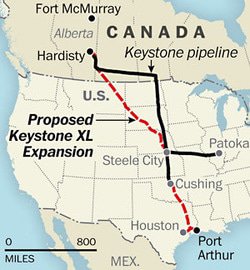The Debate Over the Keystone XL Pipeline
With a huge majority vote, the House of Representatives passed a bill in 2014 that would allow for the construction of the Keystone LX oil pipeline. The massively debated pipeline would help deliver crude oil from Canada all the way to Texas, but has been a major cause for concern for Lakota local tribes . Even though the project was approved by the House, it still needed the approval from President Obama. Obama was actually not in complete support of the pipeline. It is being built to help Canada send their oil through US land to be sold elsewhere. It will have no direct impact on US gas prices. The Democratic Senate was not in full support of the project.
 Since that time in November of 2014, there was no construction attempts on the pipeline, even though the Keystone pipeline vote was won . In fact, in 2015, the US State Department denied the required border-crossing permit needed by TransCanada. Obama declared the pipeline project as undercutting the global leadership on climate change. This was overturned when Trump took office when he issued a memorandum encouraging the approval of the pipeline xl.
Since that time in November of 2014, there was no construction attempts on the pipeline, even though the Keystone pipeline vote was won . In fact, in 2015, the US State Department denied the required border-crossing permit needed by TransCanada. Obama declared the pipeline project as undercutting the global leadership on climate change. This was overturned when Trump took office when he issued a memorandum encouraging the approval of the pipeline xl.
Pipeline Construction Approved
The TransCanada Keystone Pipeline XL has finally received the go-ahead from the Nebraska Public Service Commission in November 2017. This has allowed the nine-year hurdle to be won and the project will be underway. However, the commission has rejected the preferred route, and there has been a Keystone Pipeline vote that would move the route to the east. The new route would carry approximately 830,000 barrels of crude oil each and every day and would avoid the Sandhills region, which is ecologically delicate.
In 2012, President Obama approved the project with construction running from Oklahoma to Texas. In 2015, the TransCanada application was turned down to build the pipeline through Montana, Nebraska and South Dakota. This was a huge win for the Lakota Tribe and other Indian tribes who have been protecting the pipeline xl from running through sacred and ecological unstable areas. In 2015, there was also a major oil leak, spilling 5,000 barrels of oil into South Dakota. This was the latest leak in the existing pipeline, and there are still many concerns as to the economic impact, potential spills and climate change.
Unfortunately, the newly proposed route will still pass through parts of the Ogallala aquifer, which is one of the main sources of drinking water in Nebraska and the Great Plains. There is still much debate surrounding the new pipeline, and there are still legislative hurdles to jump over as well as local tribal protests.
Multi-Year Battle to Prevent Pipeline
Since the pipeline project has been proposed, it has been battled by many tribe in Nebraska and South Dakota, including the Lakota, Dakota and Nakota tribes. The pipeline is actually in violation of 1851 and 1868 treaties that were questioned when the Dakota Access pipeline was proposed. The Keystone XL pipeline is still being challenged by a number of tribes, including the Cheyenne River Sioux tribe. One of the memorable battles against the pipeline was Standing Rock, where hundreds, even thousands rallied to stand ground and not allow machinery to progress through sacred lands to build the pipeline. Indian tribes across America were represented at Standing Rock, protesting the pipeline.
Pipeline Obstacles
The main obstacle being faces is the route in which the pipeline xl will take. No matter which route is proposed, there are constant ecological threats as it will somehow pass through areas of Nebraska and South Dakota. Many landowners who have farms that lie along the proposed route are concerned, worried that potential spills could pollute water sources and harm cattle. It is also believed that tax revenue and jobs on the pipeline will be short-lived. Even though some major obstacles have already been cleared, there are still many in the future, which is why the actual construction has not yet started The Keystone Pipeline does not have a definite route as of now and this is one of the major issues that is stalling the project.
